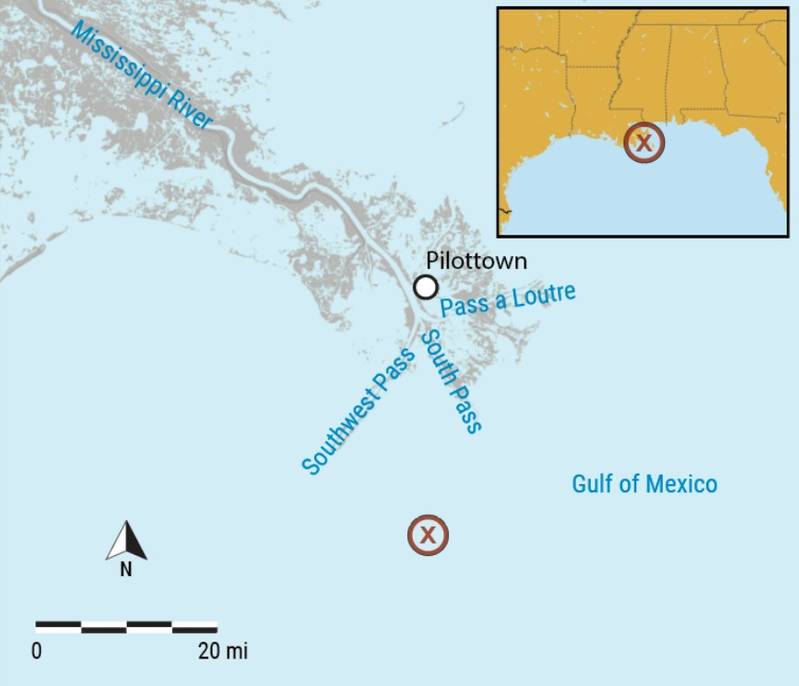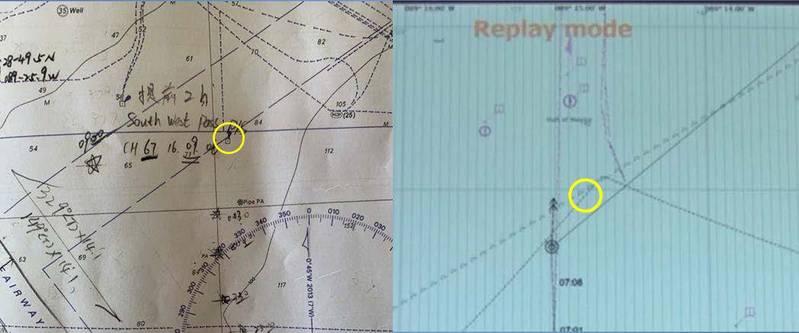On January 7, 2021, the dry bulk carrier Ocean Princess struck the uncrewed/out-of-service oil and gas production platform SP-83A while operating 24 miles south of Pilottown, Louisiana.
Now, some 19 months later, the National Transportation Safety Board has released an investigation report which showed that poor bridge resource management and a charting error led to the bulk carrier striking the oil and gas production platform.
The 24-person crew of the Ocean Princess was drifting overnight in the Gulf of Mexico before going to New Orleans to load a cargo of grain. The master planned to drift throughout the night with the engine on 15-minute standby, keeping clear of traffic and platforms, NTSB said. Area where the Ocean Princess contacted platform SP-83A, as indicated by a red X. (Credit: NTSB)
Area where the Ocean Princess contacted platform SP-83A, as indicated by a red X. (Credit: NTSB)
"To give the crewmembers rest time after cleaning cargo holds during the day, the master scheduled himself to be on the bridge with the mate on watch, supplementing the watch and the duties of the lookout. After engaging the engine to maneuver the vessel, the master stated he saw a dim yellow light and checked the radar. The master and the second officer on watch investigated the light and believed it was coming from an oil platform 5-6 miles away. Roughly 10 minutes later, the Ocean Princess struck platform SP-83A," NTSB said.
The master and second officer told NTSB investigators they never saw SP-83A on the radar.
Platform on Paper Chart But Not on Electronic One
After the contact, both noted that the platform was on the paper chart used on the bridge by the mate on the watch, but SP-83A did not appear on the electronic chart display and information system (ECDIS).
 Platform SP-83A was not charted on the official U.S. electronic or paper navigation charts that provided the chart data to the ECDIS aboard the Ocean Princess. The platform did appear on the British Admiralty paper chart that the mate on watch was using at the time of the contact. The platform had been added to the U.S. paper charts when installed in 1990, but for an unknown reason was omitted 20 years later, in 2010, from two larger-scale U.S. paper charts. It remained off the two paper charts and electronic navigation charts (ENCs) for over 11 years—until after the contact. Following the contact, the National Oceanic and Atmospheric Administration (NOAA) updated and corrected the electronic and paper charts that had been erroneously missing platform SP-83A.
Platform SP-83A was not charted on the official U.S. electronic or paper navigation charts that provided the chart data to the ECDIS aboard the Ocean Princess. The platform did appear on the British Admiralty paper chart that the mate on watch was using at the time of the contact. The platform had been added to the U.S. paper charts when installed in 1990, but for an unknown reason was omitted 20 years later, in 2010, from two larger-scale U.S. paper charts. It remained off the two paper charts and electronic navigation charts (ENCs) for over 11 years—until after the contact. Following the contact, the National Oceanic and Atmospheric Administration (NOAA) updated and corrected the electronic and paper charts that had been erroneously missing platform SP-83A.
Probable cause of the incident
"The NTSB determined the probable cause of the contact of the Ocean Princess with platform SP-83A was poor bridge resource management, which resulted in the bridge team not identifying the platform and recognizing the risk it posed to their safe navigation even though they saw its lights about 10 minutes before the casualty. Contributing was platform SP-83A not being shown on the vessel’s electronic chart display and information system due to a charting error," NTSB said.
"The effective use of all available resources by a bridge team, including paper charts, electronic charts, and radars, increases collective situational awareness and contributes to a safe navigation watch,” the report said. “When identifying hazards, bridge teams should avoid overreliance on a single data source by cross-checking information with available bridge resources and communicating identified risks with fellow watchstanders. Technology, such as an ECDIS, can result in operator overreliance and overconfidence that degrades sound navigation practices and negatively affects situational awareness.”
Damage to the vessel and platform totaled an estimated $1.5 million.
The Ocean Princess sustained damage to the starboard bow, including starboard-side handrails, the starboard anchor windlass, and the bulwark. The forward mast was knocked down. There was also damage to portside handrails. Damage to the vessel was estimated to be over $500,000.
Platform SP-83A sustained damage to ladders, walkways, and vent piping on three of four sides. Damage to the platform was estimated to be over $1 million. No pollution or injuries were reported.



